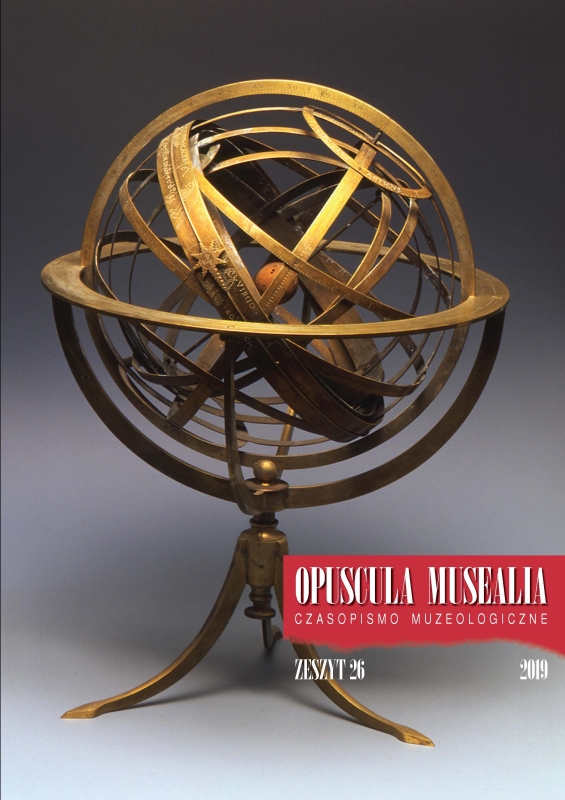„Porachowanie z Panem Auszpurczaninem”. Specyfikacje kosztów wykonania złotej figury Matki Boskiej z Dzieciątkiem i argenterii z fundacji Jana Wawrzyńca Wodzickiego dla kościoła Mariackiego w Krakowie oraz historia tych zabytków
“Getting even with Mr. Augsburgian”. Cost estimates for making the silverware and gold statue of Madonna and Child by Jan Wawrzyniec Wodzicki and donated to Saint Mary’s Basilica in Kraków
Author(s): Beata FrontczakSubject(s): Museology & Heritage Studies
Published by: Wydawnictwo Uniwersytetu Jagiellońskiego
Keywords: model woskowy; Christopher von Rad I; Balthasar Hößlin (Hösslin); srebrne antependium z Augsburga; Jan Wawrzyniec Wodzicki; Abraham II Drentwett; złota figura Matki Boskiej z Dzieciątkiem; Rad & Hößl
Summary/Abstract: Until 1794, silverware and gold statue of Madonna and Child funded as a votive offering for blessings received by Jan Warzyniec Wodzicki, the Deputy Cup-bearer of Warsaw, was kept in Saint Mary’s Basilica in Kraków. Wodzicki donated several items to his parish church: in 1690 he made a gift of six altar candlesticks, in 1692 a gold statue of a Madonna and Child on a gilt silver pedestal and a pair of kneeling angels on pedestals identical to the pedestal of the Madonna statue, and on 12 July 1694 a five-piece silver antependium. In the Archive of the Wodzicki Family from Kościelniki, kept in the Ossolineum Library in Wrocław, the author of this article has found two cost estimates for making the above mentioned silverware, except for the antependium, issued in Warsaw on 9 May 1694 by Rad & Hößlin, a trading house from Augsburg. Christopher von Rad I and Bartholomäus Hößlin (Hösslin), jewellers and goldsmiths from Augsburg, established their company in 1690. The documents found by the author are the first ones to confirm that the above mentioned jewellers from Augsburg operated in Poland. The first cost estimate (Annex I) tells us that Wodzicki gave 1,100 ducats (1,114 Augsburg ducats) for the figure of Madonna and Child. The labour cost of both figures, a case and a travelling bag was 559 imperial thalers and 11 kreutzers (the cost of a wax model and forming the body out of gold sheet cost 35 imperial thalers, whereas the repoussage of the body cost 498 imperial thalers and 11 kreutzers). In accordance with the second specification (Annex II), the goldsmith was paid 1,847 imperial thalers and 30 kreutzers for the candlesticks. The labour cost of making two statues of angels on pedestals was 536 imperial thalers and 22½kreutzers, whereas making the pedestal for the statue of the Madonna and Child cost 182 imperial thalers and 78 kreutzers. The cost estimate of the silver antependium for the main altar has not survived. The inventory of Saint Mary’s Basilica in Kraków shows that the five-piece antependium weighed 206 grzywnas (ancient Polish measure of weight) and cost 14,856 tymf (Polish silver coins).The works were most probably the result of one workshop, and were perhaps by Abraham II Drentwett (1647–1729), a goldsmith, wax sculptor and draughtsman from Augsburg.During the Kościuszko Uprising in 1794, the above mentioned silverware, except for the statues of angels, were taken from the treasury of the basilica by the Order Committee established by Tadeusz Kościuszko and melted down to support the uprising. In 1807, the two statues of angels funded by Wodzicki were sold to goldsmiths from Kraków.
Journal: Opuscula Musealia
- Issue Year: 2019
- Issue No: 26
- Page Range: 101-141
- Page Count: 41
- Language: Polish

